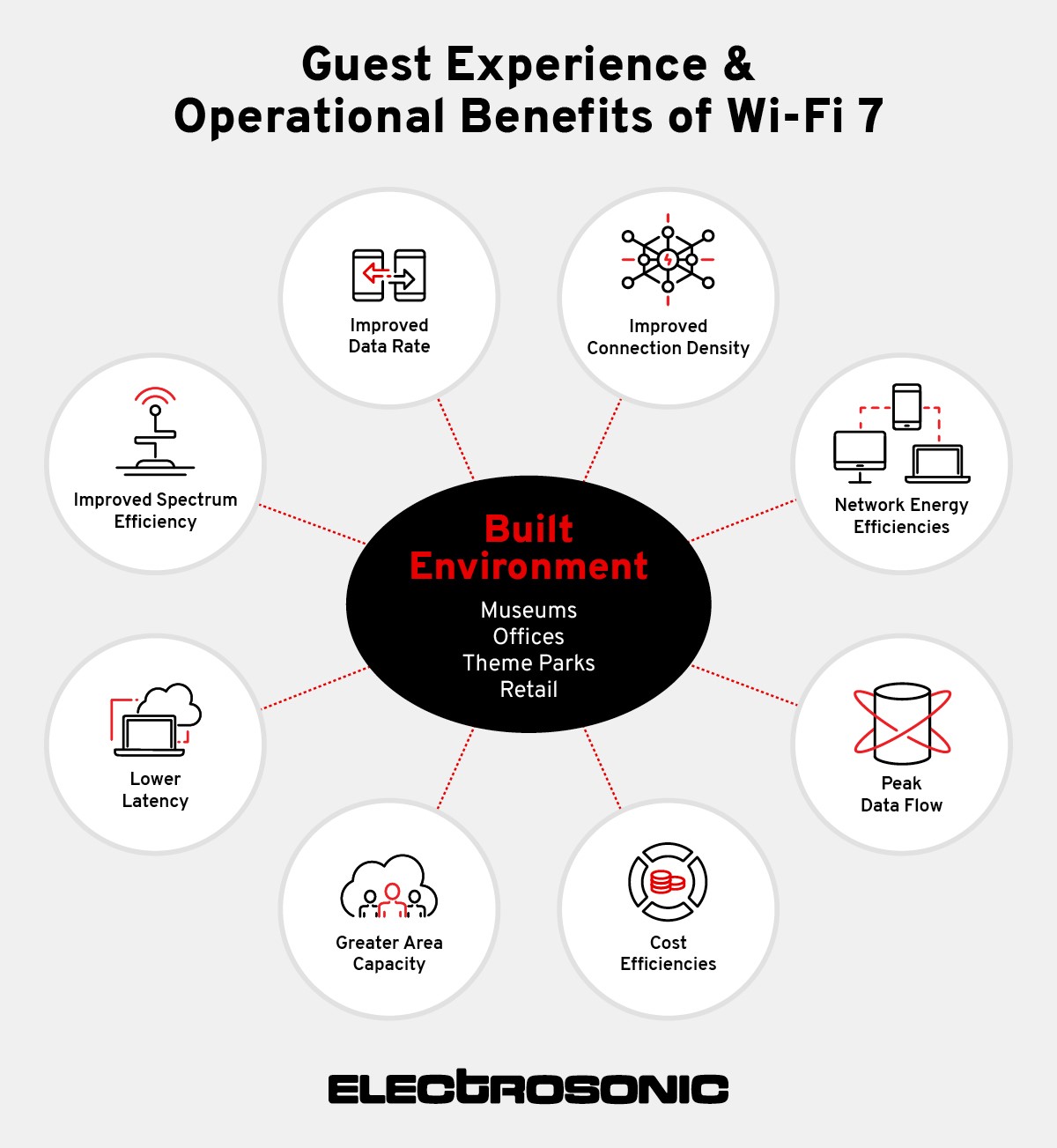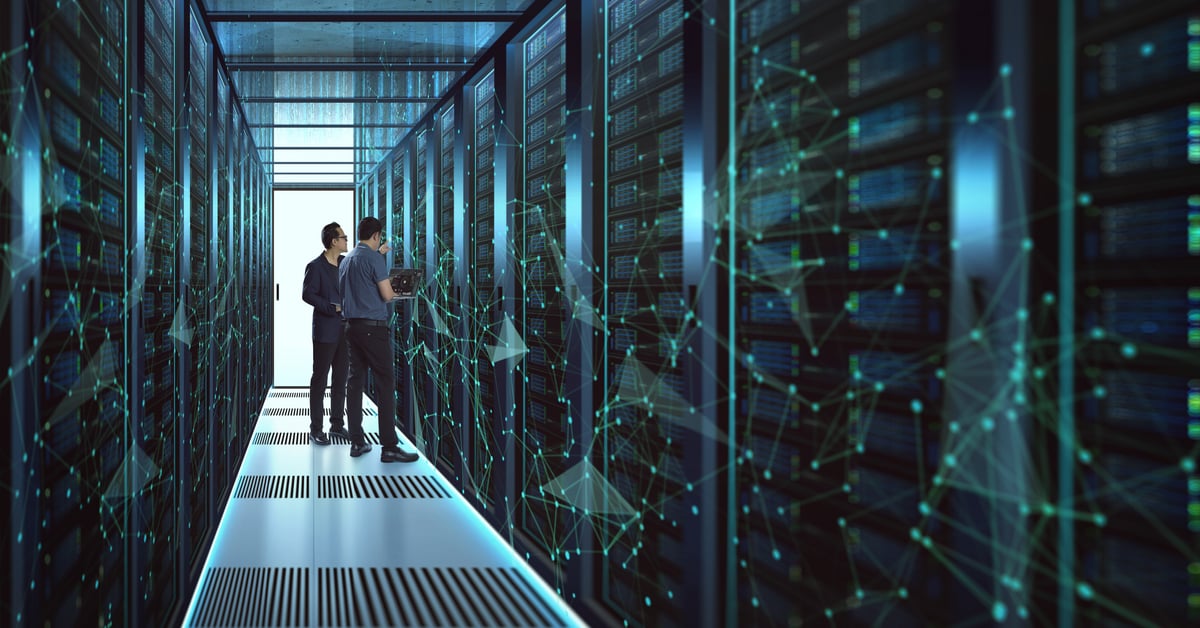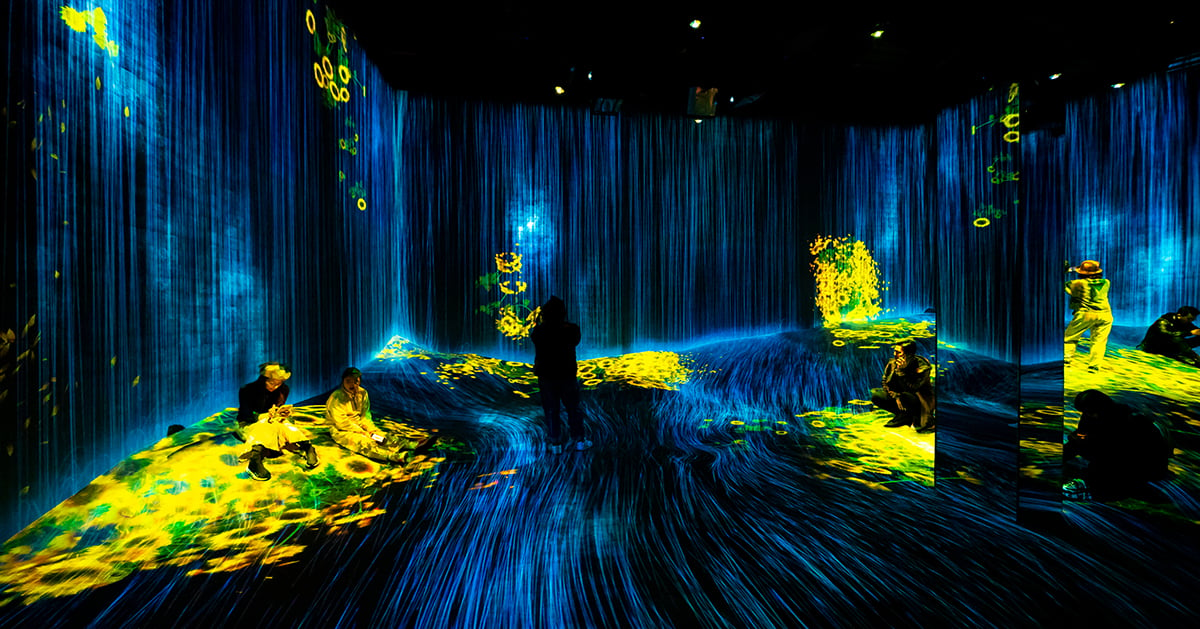
The benefits of Wi-Fi 7 in immersive environments
Wi-Fi 7 is the latest stage in the evolution of Wi-Fi standards. It meets increasing demands for improved speed, reliability, bandwidth, latency and data transfer capability in immersive environments.
IT, Engineering, Design teams, Experience Architects and Content Producers can use Wi-Fi 7 to improve operational and guest experiences.
Why Wi-Fi 7 technology is essential
There has been a dramatic increase in the use of mobile technology in high-traffic corporate and leisure environments. As a result, IT and Engineering professionals face increasing demands for high-speed, ultra-reliable wireless connectivity.
Existing Wi-Fi technology cannot support the connectivity required for agile, high-performance wireless networks and applications. This can lead to user or guest frustration with poor Wi-Fi performance. The benefits of Wi-Fi 7 can help IT and Engineering teams meet those emerging application and operational challenges.
Wi-Fi 7 also opens new opportunities for enabling or improving experiential and immersive environments. These environments require high-speed data transmission to support integrated technologies and data-intensive applications such as data sharing, 8K video streaming, real-time communication or online gaming. Poor connectivity limits the use of these advanced technologies.
Evolution of Wi-Fi standards
Wi-Fi standards continue to evolve to meet changing performance demands. Wi-Fi 7 is the successor to Wi-Fi 6 and Wi-Fi 6E. Wi-Fi 6 represented a milestone in wireless connectivity. It significantly improved performance and reliability by utilizing both 2.4 and 5 GHz bands. Speeds increased from 6.9 Gbps to 9.6 Gbps.
Wi-Fi 6E added a 6 GHz band to reduce latency and increase bandwidth. That version added more channels (21 in total) to minimize the risk of interference in crowded areas. Wi-Fi 6E also introduced wider channels to improve router performance. Wi-Fi 7 is the latest version. It builds on the speed and performance of Wi-Fi 6 and 6E and adds further advanced features described below.
Technical benefits of Wi-Fi 7
Wi-Fi 7 incorporates four essential features to improve performance and reliability in immersive environments:
- Extremely High Throughput (EHT) enables speeds up to 46 Gbps, compared to a previous maximum of 9.6 Gbps. It also supports applications requiring massive data transfer.
- Multi-Link Operation (MLO) supports simultaneous data transfer across various bands and channels. This reduces latency, allowing seamless data transfer in high-traffic environments.
- Enhanced Channel Width enhances overall network performance and enables concurrent transfer of more data.
- Improved Quadrature Amplitude Modulation (QAM) provides four times greater modulation than previous versions. This improves signal quality, supports faster data rates and increases data transmission efficiency.

Guest experience and operational benefits of Wi-Fi 7
Designers and business owners can use these improvements to transform the operational and guest experiences of wireless applications. They can improve the performance or scope of existing applications in immersive environments. They can also accelerate the development of next-generation wireless applications, including augmented reality.
In museums, theme parks and attractions, designers can use Wi-Fi 7 performance to transform interactive exhibits, support virtual tours and enable seamless augmented reality experiences. In other location-based entertainment venues, Wi-Fi 7’s reliability can ensure uninterrupted entertainment and guest experiences in high-traffic environments.
Wi-Fi 7’s high-speed, high-capacity data transfer capability will provide greater access to insights on usage. This helps owners and operators track visitor behavior for planning or responding to incidents.
In transportation hubs, Wi-Fi 7 can support real-time information systems and streamline security processes. The technology can improve passenger experience by supporting advanced placemaking and entertainment applications.
Wi-Fi 7 technology plays a crucial role in corporate enterprise spaces. It supports the integrated technologies that can accelerate digital transformation and data-based decision-making. Enhanced connectivity will help businesses streamline operations and improve cloud computing efficiency.
In customer engagement spaces, Wi-Fi 7 can support advanced applications that enhance the meeting experience and improve outcomes. It will also enable more efficient remote working through seamless collaboration and high-definition video conferencing.
There are also benefits for other sectors, including gaming and hospitality, retail, sports and arenas, theatres and higher education. In the corporate enterprise sector, Wi-Fi 7 can also enhance user guest experience in lobbies, courtyards and specialty spaces.

Deploying Wi-Fi 7 technology
Wi-Fi 7 promises significant benefits across all sectors. To take advantage of this important new standard, Wi-Fi 7 can upgrade an existing Wi-Fi system or be deployed as a new installation.
A Wi-Fi 7 deployment can form part of a Wi-Fi or IT infrastructure upgrade. IT teams can deploy Wi-Fi 7 as a ‘rip & replace’ project or as an add-on to an existing Wi-Fi deployment.
Wi-Fi 7 technology is backwards compatible with earlier Wi-Fi standards. It also offers broader interoperability capabilities with various infrastructure components, applications and integrated technologies.
If Wi-Fi 7 is deployed as a new installation, IT teams must consider infrastructure, power requirements, and other design considerations outlined below.
Design considerations
For a successful Wi-Fi 7 deployment, IT and Engineering teams must consider several crucial factors.
- Design vision – What is the role and functionality of Wi-Fi technology in the application or environment?
- Wi-Fi performance considerations – How should the installation perform regarding speed, latency, reliability and other relevant factors?
- Will the system be deployed in a high-traffic environment for crowd size and flow?
- Physical barriers – Are there any physical barriers that could affect RF signal propagation?
- Accessibility for Wi-Fi infrastructure – How easy or difficult is providing power or other essential infrastructure to the planned location?
- Integration of Wi-Fi infrastructure – Can Wi-Fi 7 infrastructure be integrated with other ICT components to rationalize power and network requirements?
- Operating and support considerations – How will teams operate, manage and maintain the Wi-Fi 7 installation?
Design and deployment stages
A Wi-Fi 7 installation goes through several critical stages:
- Review the design vision and performance requirements
- Assess infrastructure, power and cabling requirements
- Check device compatibility
- Carry out detailed infrastructure design
- Consider integration with the broader ICT infrastructure
- Complete installation, integration and configuration
- Conduct testing and training
Deploying Wi-Fi 7 requires design, installation and integration skills, resources, and knowledge of the latest Wi-Fi solutions. If those internal skills are unavailable, working with specialists is essential.

Support for Wi-Fi technology
Electrosonic can provide essential support. We have an expert understanding of wireless applications in all vertical sectors and deep collaborative relationships with exhibit and experience designers, architects, interior designers, and specialist contractors.
We can support your internal teams with a single source of professional design, build and integration services for Wi-Fi planning and deployment. These services include:
- Technology Master Planning™
- Technology Design Consulting
- Structured cabling system design
- LAN and WAN infrastructure design
- Campus and external plant infrastructure design
- Converged technology system infrastructure design
- Data center and cloud storage infrastructure
- Wi-Fi network system infrastructure design
- Onsite and remote support services
The ground-breaking features of Wi-Fi 7 technology represent a significant leap forward in wireless technology. Wi-Fi 7 introduces a new era of advanced wireless connectivity and opens new creative opportunities for designers to enhance user and guest experiences.
Wi-Fi 7 also sets expectations for the future of Wi-Fi technology. Further developments, beginning with Wi-Fi 8, will focus on improved data rates, reduced latency and jitter, and better wireless medium reuse strategies and power-saving features. While those developments are in the future, Wi-Fi 7 is available now.
Ryan Poe
Ryan Poe, Electrosonic’s Director of Technology Solutions, works and writes on the frontiers of advanced technology. He is a trusted adviser on leveraging technology in new ways and works within our Innovation Garage framework to evaluate new technologies and develop resources that support a portfolio of advanced services.










.jpg?width=1500&height=995&name=ELC501_N17_medium%20(1).jpg)

![[Discover how to create an agile, high-performance infrastructure]](https://no-cache.hubspot.com/cta/default/5104351/f36b7eee-6675-4046-8f17-fd9e5c512817.png)








.jpg)















.jpg)




.jpg)




.jpg)
-png.png)










.jpg)




.jpg)


-(1)_1200x629px.jpg)




.jpg)
.jpg)





-RR.jpg)






.png)




.jpg)






.png)





















%20(1)-es.jpg)
.jpg)








.jpg)

.jpg)





.jpg)



.jpg)















.png)

.png)





























.jpg)
.png)





.png)

.jpg)


.png)






.jpg)
.jpg)


